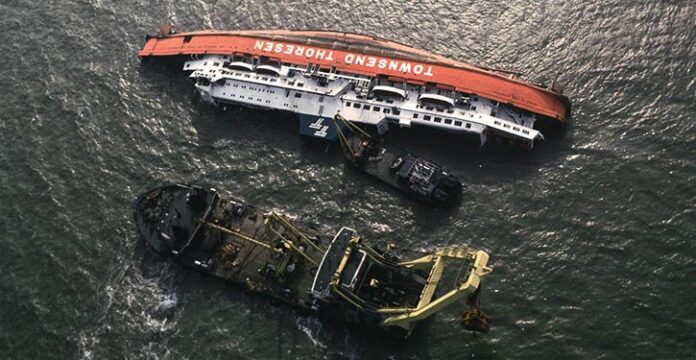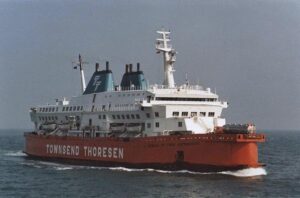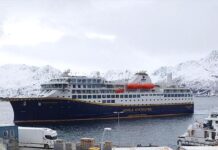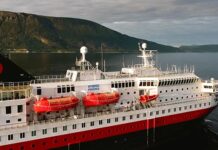
RoRo ferry capsized and sank on 6 March 1987 with 193 lost lives

MS Herald of Free Enterprise was a roll-on roll-off (RORO) ferry built by Schichau Unterweser AG, Bremerhaven in 1980. Her length was 131,9 m overall and featured 7951,44 to gross and 3499,05 to net register. The ferry which capsized moments after leaving the Belgian port of Zeebrugge on the night of 6 March 1987, killing 193 passengers and crew, of the 539 people aboard.
The modern 8-deck car and passenger ferry, owned by P&O, had been designed for rapid loading and unloading on the competitive cross-channel route, and there were no watertight compartments. When the ship left harbour with her bow-door open, the sea immediately flooded the decks, and within minutes she was lying on her side in shallow water. The immediate cause of the sinking was found to be negligence by the assistant boatswain, asleep in his cabin when he should have been closing the bow-door. But the official inquiry placed more blame on his supervisors and a general culture of poor communication in the ferry company P&O European Ferries. Although the vessel was salvaged and put up for sale, there were no takers, and she ended her days in a scrapyard in Taiwan. Since the disaster, improvements have been made to the design of RORO vessels, with watertight ramps, indicators showing the position of the bow-doors, and the banning of undivided decks. This incident caused the highest death-count of any peacetime maritime disaster involving a British ship since the sinking of the RMS EMPRESS OF IRELAND in 1914.
In Context
The final death toll was 193. The disaster had unfolded in just 90 seconds, in calm conditions and shallow water, only 100 yards (91m) from the shore.
The turnaround time for loading and unloading at Zeebrugge was longer than at most other ports because there was only room for access to a single ramp onto the car deck. Water had to be pumped into the ballast tanks to lower the level of the ferry. It appears the ferry then left port with her bow doors open and the extra ballast still in her tanks. Water began flowing onto the car deck and the vessel quickly became unstable.
A formal investigation blamed company management for failing to give clear instructions about safety procedures. New safety measures were finally brought into effect in 1999 following a second ferry disaster. The ESTONIA sank in 1994 with the loss of 850 lives. Passenger details now have to be recorded before a ship sails so the harbour authorities know who is on board. Cameras have also been fitted to the front of ships so the crew can see from the bridge whether or not the doors have been closed before sailing.



